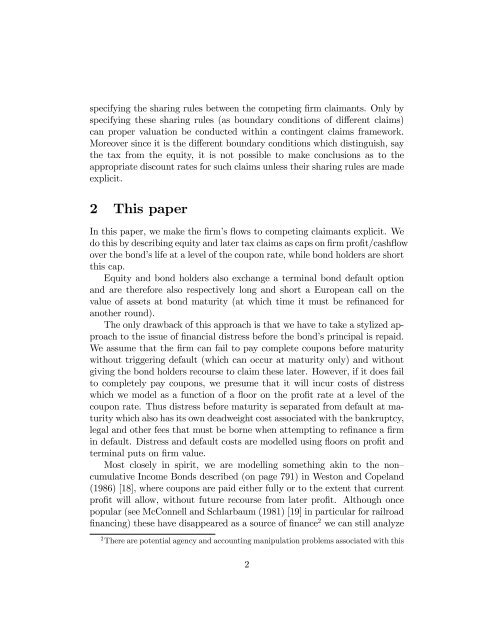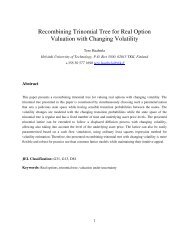Valuing a firmks capital structure using profit caps, floors and bond ...
Valuing a firmks capital structure using profit caps, floors and bond ...
Valuing a firmks capital structure using profit caps, floors and bond ...
Create successful ePaper yourself
Turn your PDF publications into a flip-book with our unique Google optimized e-Paper software.
specifying the sharing rules between the competing …rm claimants. Only byspecifying these sharing rules (as boundary conditions of di¤erent claims)can proper valuation be conducted within a contingent claims framework.Moreover since it is the di¤erent boundary conditions which distinguish, saythe tax from the equity, it is not possible to make conclusions as to theappropriate discount rates for such claims unless their sharing rules are madeexplicit.2 This paperIn this paper, we make the …rm’s ‡ows to competing claimants explicit. Wedo this by describing equity <strong>and</strong> later tax claims as <strong>caps</strong> on …rm pro…t/cash‡owover the <strong>bond</strong>’s life at a level of the coupon rate, while <strong>bond</strong> holders are shortthis cap.Equity <strong>and</strong> <strong>bond</strong> holders also exchange a terminal <strong>bond</strong> default option<strong>and</strong> are therefore also respectively long <strong>and</strong> short a European call on thevalue of assets at <strong>bond</strong> maturity (at which time it must be re…nanced foranother round).The only drawback of this approach is that we have to take a stylized approachto the issue of …nancial distress before the <strong>bond</strong>’s principal is repaid.We assume that the …rm can fail to pay complete coupons before maturitywithout triggering default (which can occur at maturity only) <strong>and</strong> withoutgiving the <strong>bond</strong> holders recourse to claim these later. However, if it does failto completely pay coupons, we presume that it will incur costs of distresswhich we model as a function of a ‡oor on the pro…t rate at a level of thecoupon rate. Thus distress before maturity is separated from default at maturitywhich also has its own deadweight cost associated with the bankruptcy,legal <strong>and</strong> other fees that must be borne when attempting to re…nance a …rmin default. Distress <strong>and</strong> default costs are modelled <strong>using</strong> ‡oors on pro…t <strong>and</strong>terminal puts on …rm value.Most closely in spirit, we are modelling something akin to the non–cumulative Income Bonds described (on page 791) in Weston <strong>and</strong> Copel<strong>and</strong>(1986) [18], where coupons are paid either fully or to the extent that currentpro…t will allow, without future recourse from later pro…t. Although oncepopular (see McConnell <strong>and</strong> Schlarbaum (1981) [19] in particular for railroad…nancing) these have disappeared as a source of …nance 2 we can still analyze2 There are potential agency <strong>and</strong> accounting manipulation problems associated with this2



